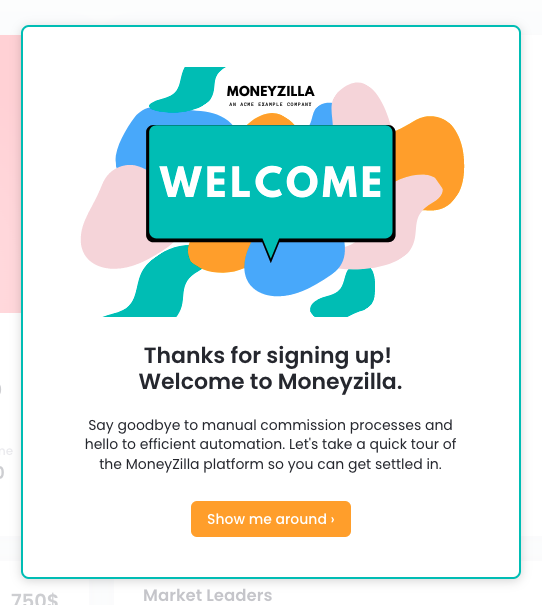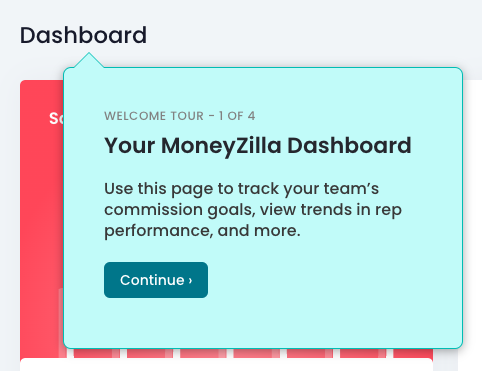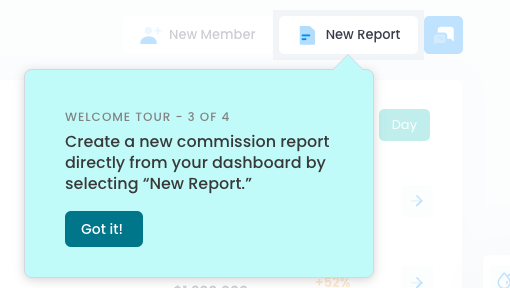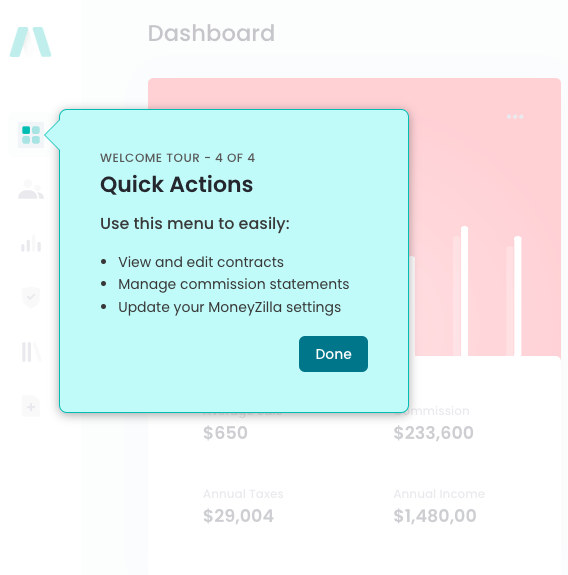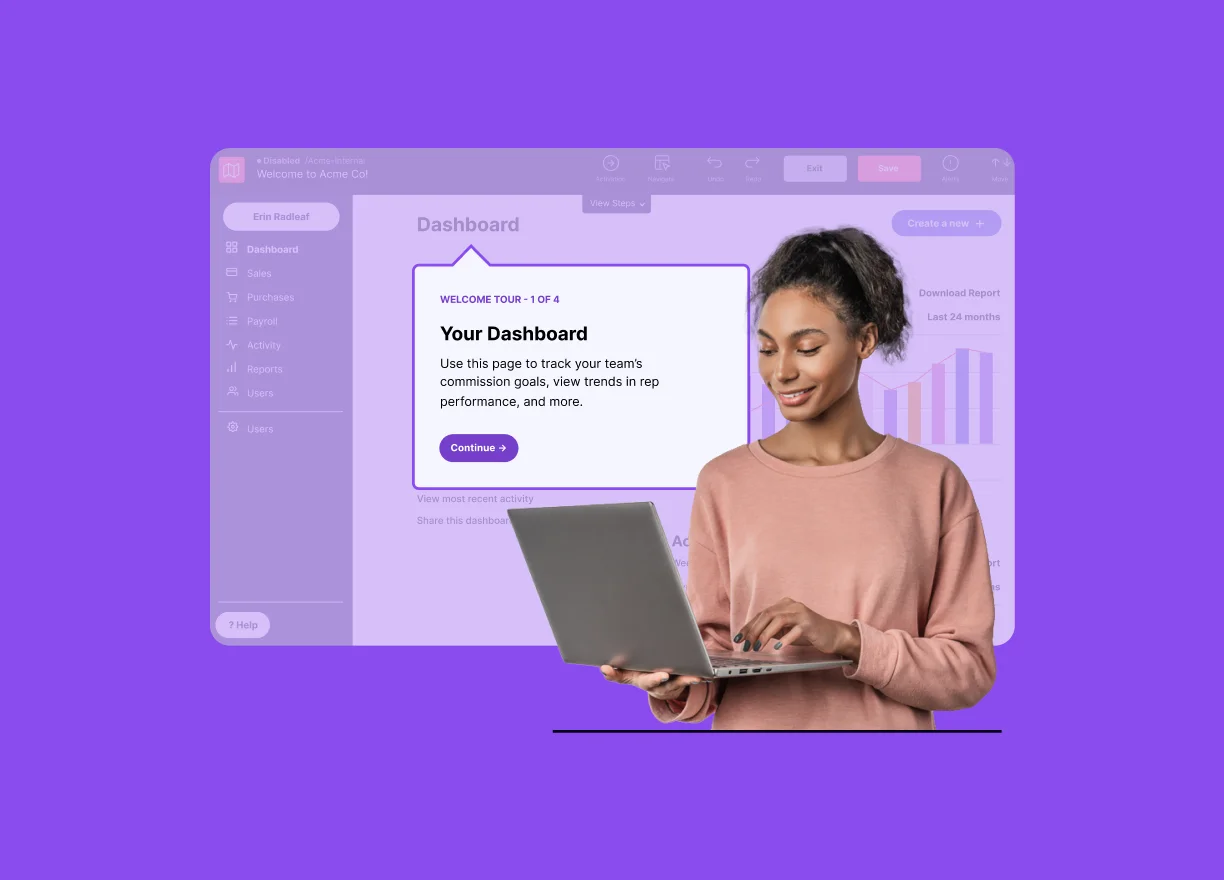
プロダクトマネージャー向けガイド
顧客向けオンボーディング
プロダクト使用法の学習を通じて顧客を導く手段
さらに深く掘り下げる
目次
顧客オンボーディングとは
Customer onboarding is the process of guiding new users through the initial stages of understanding how to use your product. The goal of customer onboarding is to drive product adoption, where users find navigating the app easy and satisfying. It’s about helping them understand its value proposition, develop the skills they need to succeed, and ultimately, become productive and enthusiastic users.
効果的な顧客オンボーディングが重要な理由
オンボーディングは、初めてプロダクトを使用する顧客やユーザーに対して最も価値のあるフィーチャーをアピールするタイミングであり、価値実現までの時間を短縮できます。開発・販売する対象が何であれ、顧客がプロダクトを初日から学ぶのを支援することが重要です。
適切に構成されたオンボーディングプログラムには、以下のような多くの利点があります。
- Faster product adoption: An educational, smooth onboarding experience creates a positive first impression and leads users to value as fast as possible. Onboarding is your time to lead customers to high-value features and workflows, accelerating their “aha!” moments and increasing product usage.
- Increased customer retention: By giving users the knowledge and skills they need to be successful, you can build enduring habits that keep users returning to your product over time. Satisfied customers are also more likely to stick around for the long haul and become loyal brand advocates.
- Fewer support tickets: While some technical challenges submitted via support ticket or call do require human intervention, a vast number—particularly those related to basic or routine activities like onboarding, account set-up, or basic troubleshooting—don’t. Clear, proactive guidance via onboarding helps you minimize reactive support requests.
顧客オンボーディングの改善方法
顧客が初めてプロダクトにログインする際のオンボーディングプロセスがわかりにくい(または不足している)場合、ユーザーのフラストレーションや摩擦につながり、最終的には解約リスクを生みます。しかし、優れたオンボーディングプロセスがあれば、主要なワークフローを通じてユーザーをガイドし、重要なツールを強調し、プロダクトのユーザーインターフェース(UI)を紹介できます。適切なオンボーディングプロセスを顧客に提供するために、以下のヒントを参考にしてください。
- Personalize onboarding for your audience: Tailor your onboarding experience to multiple user audiences based on their needs, goals, and behavior. if the app serves different user roles, tailor onboarding to the specific needs of each persona or employee role. By designing onboarding for each unique type of user, companies can drive new users to their specific a-ha moments more quickly and deliver the context needed to keep users engaged.
- Use in-app messaging and resource centers: In-app guides are a simple, always-on way to automatically onboard users, at scale. Serve educational content and workflows to users, from account setup to new feature announcements.
- Track and analyze engagement: Monitor key onboarding metrics and continuously iterate on your onboarding flow to optimize its effectiveness. Use interactive elements like tooltips, walkthroughs, and checklists to keep users interested and actively learning.
ユーザーの定着化を促進する顧客オンボーディングプロセスの作成方法
オンボーディングは、ユーザーが初期のサインアップからプロダクトに習熟した熱心な支持者になるまでを導く多段階のプロセスです。ここでは、オンボーディングの典型的な段階と各段階の効果的な構成方法、そして各段階で達成すべき目標をご紹介します。
ステップ1:ユーザーを歓迎する
User onboarding should include an introduction to the app, and an orientation to the main navigation patterns. With an onboarding welcome experience, users will understand the general purpose of the app, and how to access the pages and areas needed to complete key tasks. You can add video footage, or other content here. Here’s an example of a welcome pop-up:
ステップ2:構成を通じてユーザーを導く
一部のプロダクトでは、ユーザーが開始する前にセットアップまたはインストールが必要です。ファイル共有またはコラボレーションツールでは、ユーザーは連絡先またはチームメイトを追加する必要があります。音楽発見アプリでは、ユーザーはリスニング設定を定義する必要があります。オンボーディングは、重要な成果を達成するために必要な設定ステップをユーザーに案内する必要があるのです。
ステップ3:ユーザーをペイオフタスクに誘導する
ユーザーが最初にプロダクトにたどり着くきっかけとなった行動や成果を体験したときに、ペイオフタスクが発生します。
For a to-do app, this might be checking off a task. For a billing tool, it might be receiving payment from a customer. These payoff tasks are often paired with a setup task. For the task management app, before a task can be completed, the user must first create a task. Effective user onboarding will guide the user through the payoff tasks, while calling attention to the setup tasks that make up the complete process.
定着化は、コア機能を通じてユーザーを導き、プロダクトの定着化を促進するためにユーザーが早期に成果を上げることを支援します。
ステップ4:メンテナンスモード
ユーザーのアクティビティをモニタリングし、フォローアップメッセージを送信し、潜在的なアップセルの機会を特定し、質問や障害に対処するための継続的なサポートを提供します。
顧客オンボーディングのベストプラクティス
プロダクト主導型企業は、ユーザーがプロダクトの価値を直感的に発見する能力に大きく依拠しています。ここでは、このユーザー中心のアプローチでオンボーディングプロセスを最適化する方法をご紹介します。
- Prioritize usability: First and foremost, ensure your product is user-friendly. An intuitive interface with straightforward navigation minimizes the need for extensive upfront instruction. Focus on a clean layout, logical user flows, and consistent design elements to guide users through the product naturally.
- Offer in-app guidance: While a user-friendly product is essential, some level of guidance can be beneficial. PendO In-app Guides empower you to highlight core functionalities right when users need them. These contextual walkthroughs can appear on relevant screens, guiding users through key features and showcasing their value proposition. This targeted approach avoids overwhelming users with information upfront while ensuring they discover the product’s full potential.
- Contextual help at every step: Supplement guides with a robust contextual help system within the product. Contextual tooltips, for example, can appear on hover or click, providing brief explanations of specific UI elements or functionalities. A readily accessible knowledge base with searchable articles allows users to find answers to their questions independently, fostering self-sufficiency and reducing reliance on external support channels.
- Data-driven optimization: Don’t be afraid to iterate and improve your onboarding strategy. Utilize user behavior data from your product analytics to personalize onboarding experiences and identify areas for improvement. See which features users struggle with and adjust your in-app guidance accordingly. Track completion rates for onboarding steps and identify bottlenecks hindering user progress. You can refine your onboarding process by continuously analyzing user data to ensure it remains effective and engaging for all user segments.
このベストプラクティスに従うことで、ユーザーが自力でプロダクトの価値を発見しながら最も必要なタイミングで最適なガイドやサポートを提供できる、プロダクト主導型のオンボーディング体験を作成できます。このアプローチによりユーザーのオーナーシップを育み、長期的なプロダクト定着化および成功への基盤が整います。
ユーザータイプに合わせて顧客オンボーディング体験をパーソナライズする方法
オンボーディングを成功させるには、汎用的なアプローチが機能することはめったにないと認識することから始めましょう。ユーザーによって、ニーズ、目標、学習スタイルは異なります。オンボーディング体験をパーソナライズすることで、多様なユーザーセグメントに対応し、多くの人にとって魅力的でわかりやすいジャーニーを実現できます。
ここでは、オンボーディング戦略をパーソナライズする方法をご紹介します。
- Segment by user persona: Developing user personas is a valuable exercise that allows you to define your ideal customer archetypes. By considering user roles, goals, pain points, and technical expertise, you can tailor onboarding experiences to resonate with each persona. For example, a new marketing user might benefit from an onboarding flow focused on campaign creation tools, while a technical user might need a deeper dive into product integrations.
- Leveraging user data: The wealth of data you collect during signup and user interactions offers a goldmine for personalization. Use this data to personalize greetings, content, and in-app guidance. For instance, welcome new users by name and highlight features that directly address their needs based on their signup information. Behavioral data can also be used to tailor in-app guidance. A timely walkthrough can offer personalized assistance if a user is struggling with a particular feature.
- Offer flexible learning paths: Users have different learning styles. Some prefer self-paced exploration, while others might benefit from more structured guidance. Providing a variety of onboarding options caters to these preferences. Offer self-paced tutorials, interactive walkthroughs, or personalized training sessions for complex user segments. This flexibility empowers users to choose the learning path that best suits their needs and maximizes their knowledge retention.
オンボーディング体験をパーソナライズすることで、ユーザーとユーザー固有のニーズを理解していることを示すことができます。パーソナライズはつながり感を育み、プロダクトとの長期にわたる良好な関係を築くための土台を整えます。
ユーザーエンゲージメントを維持する顧客オンボーディングのUIパターン
Onboarding is a crucial opportunity to capture user attention and set the stage for a successful product experience. Engaging UI patterns play a vital role in keeping users interested and motivated as they navigate the initial learning curve. Tools like Pendo In-app Guides let you use different UI patterns that transform onboarding from a static process to a dynamic and interactive journey.
- Tooltips: These bite-sized nuggets of information appear when hovering or clicking, providing contextual help and quick tips precisely when users need them. Tooltips are ideal for highlighting specific UI elements, explaining functionalities, or offering keyboard shortcuts without overwhelming users with excessive information.
- Walkthroughs: Walkthroughs guide users through essential workflows and functionalities within your product. They can be invaluable for introducing new features or complex tasks. By showcasing the process visually and interactively, walkthroughs ensure users understand not only what to do but also how to do it effectively.
- Checklists: Complex tasks can feel daunting. Checklists break down these tasks into smaller, more manageable steps, providing a clear roadmap for users to follow. As users complete each step, the checklist provides a sense of accomplishment and motivates them to continue through the onboarding process.
- Overlays: Overlays offer a visually distinct way to highlight key features and functionalities within your product. These interactive elements can include text, images, or even short videos to grab user attention and showcase the value proposition of specific features. Overlays effectively draw attention to new features, limited-time promotions, or critical information that users might otherwise miss.
- Modals: While overlays provide a more subtle approach, modals can deliver important announcements, personalized messages, or critical onboarding steps that require user input. The temporary nature of modals ensures they don’t disrupt the overall user flow, yet their prominent placement guarantees user attention.
重要なのは、ユーザーの特定のニーズと強調したい機能に合わせてアプローチを調整することです。このようなUIパターンをオンボーディング戦略として組み込むことで、ユーザーのモチベーションを維持し、成功に向けて順調に進行する魅力的でインタラクティブな体験を構築できます。
改善のために追跡・分析すべき顧客オンボーディング指標
主要な顧客オンボーディング指標を追跡および分析することで、ユーザーの行動に関する貴重なインサイトが得られ、改善すべき領域を特定できます。このデータによりオンボーディングプロセスが継続的に改善され、ユーザーがスムーズに遷移し、迅速かつ効率的に目標を達成できるようになります。
ここでは、追跡・分析すべき重要な顧客オンボーディング指標をいくつかご紹介します。
- Guide engagement: Guide engagement measures how users interact with the in-app guides within your product. We measure the percentage of users who engaged with the guide (i.e. by clicking on the link or button, excluding “dismiss” actions), by the total number of visitors who saw this subset of guides. The median product has a guide engagement rate of 28.5%.
- Feature adoption: This metric tracks how many users actively engage with your product’s different features. Understanding which features customers use and which they neglect helps you identify potential roadblocks or areas where users might require additional guidance. By analyzing feature adoption rates, you can tailor your onboarding journey to highlight the most valuable functionalities and ensure users discover the full potential of your product.
- Completion rate: Monitor the percentage of users who complete key onboarding steps, such as creating a profile, completing a tutorial, or achieving a specific milestone within the product. Low completion rates for critical steps indicate areas where users might face friction or confusion. Analyzing completion rates allows you to pinpoint these obstacles and refine your onboarding process to ensure users stay engaged and successfully navigate the initial product experience.
- Time to value: This metric measures how long it takes users to achieve their first success with your product. The faster users experience the value proposition of your product, the more likely they are to become engaged and retained customers. Analyzing time to value helps you identify bottlenecks in the onboarding journey that delay user progress. By streamlining onboarding steps and highlighting core functionalities, you can minimize the time it takes users to experience the “aha!” moment and unlock the true value of your product.
- Net promoter score (NPS): The NPS is a valuable indicator of user satisfaction and loyalty. By sending NPS surveys after users complete the onboarding process, you can gauge their perception of your product and identify areas for improvement. High NPS scores indicate a positive onboarding experience that fosters user satisfaction and brand advocacy. Analyzing NPS data alongside other onboarding metrics allows you to identify correlations between specific onboarding elements and overall user sentiment.
このような指標を追跡することで、改善すべき領域を特定し、オンボーディングプログラムを継続的に最適化してその効果を最大化できます。
顧客オンボーディングの一般的な課題とその克服方法
どんなに綿密に作られたオンボーディングプログラムでも、障害に遭遇することがあります。ここでは、企業が直面する一般的な課題と併せ、それを克服するための戦略を詳しく見ていきます。
- Inconsistent onboarding experiences: A disjointed onboarding journey can leave users confused and frustrated. Imagine a new user encountering different onboarding steps or conflicting information depending on their signup method. To avoid this pitfall, develop a clear and repeatable onboarding framework. This framework should define a consistent sequence of steps and touch points that all users experience, regardless of their entry point. Standardization ensures a smooth and seamless onboarding journey for everyone.
- Incomplete user data hampering personalization: The effectiveness of personalized onboarding experiences hinges on accurate and up-to-date user data. Incomplete data can lead to providing irrelevant content and missed opportunities to connect with users on a deeper level. Invest in data quality management practices. This might involve implementing data validation steps during signup, offering incentives for users to complete their profiles, and regularly reviewing and cleaning your user data. By maintaining high-quality user data, you can personalize onboarding experiences and ensure they resonate with each user’s needs.
- Limited resources for onboarding initiatives: For smaller companies or startups, allocating resources for a comprehensive onboarding program can be challenging. However, a robust onboarding program is crucial for user acquisition and retention. Explore automation opportunities to streamline repetitive tasks associated with onboarding. For instance, Pendo’s Guides let you automate walkthroughs and in-app communication, freeing up your team’s time and valuable resources to focus on more strategic initiatives. Additionally, consider creating a resource center that empowers users to find answers independently, reducing the burden on your support team.
このような一般的な課題を認識し、提案されたソリューションを実装すると、オンボーディングプログラムの効率と効果を維持し、特定のニーズやリソースに適応できるようになります。
オンボーディングプロセスの成功は、1回限りのイベントではなく、継続的なジャーニーであることを忘れないでください。ユーザーの行動を継続的にモニタリングし、オンボーディング戦略を反復することで、障害を克服し、ユーザーを成功に導く優れたオンボーディング体験を生み出すことができます。
ユーザーに、状況に即した適切なサポートをタイムリーに提供する
プロダクト主導型企業での顧客オンボーディングの成功例
ここでは、Pendoのお客様がアプリ内ガイドを使用して、効果的なアプリ内オンボーディング体験を作成した事例を簡単にご紹介します。
MagHub(エンタープライズリソース管理):
- 課題:新規ユーザーのオンボーディングに膨大な負荷がかかる複雑なプラットフォーム。カスタマーサクセス(CS)チームは、基本的なトレーニングタスクに追われていました。
- ソリューション:基本的な機能に関するアプリ内ガイドを自動化し、CSチームが戦略的コンサルティングに専念できるようにしました。ユーザーは、ホームページを紹介するガイド、ウォークスルーを伴うパーソナライズされたクイックスタートチェックリスト、リマインダーポップアップにより、確実にプロセスを完了できるようになりました。
- 結果:CSチームのオンボーディング時間が半減し、ユーザーエンゲージメントを通じて顧客リテンションが向上しました。
ShippingEasy(配送とフルフィルメント):
- 課題:時間に追われるオンライン小売業者が、プラットフォームの価値をより素早く学ぶことを望んでいました。
- ソリューション:注文のセットアップなど、アプリの主要タスクを紹介するインタラクティブなウォークスルーを導入し、学習時間を最小化して生産性を最大化しました。
- 結果:ユーザーが注文の処理やビジネスの成長に集中できるため、プラットフォームの定着率が増加しました。
Oranj(金融サービス):
- 課題:オンボーディング中にユーザーがウェルカムモーダルをスキップし、アプリ内で迷うことにより、アプリのリテンションが低下していました。
- ソリューション:成功ユーザーに基づき、個々のユースケース(投資やクライアント管理)ごとにパーソナライズされたウェルカムモーダル、エンゲージメント向上を図るモーダル設計の改善、データ主導型パスを提案しました。
- 結果:ターゲットを絞ったオンボーディングと解約率の低下により、定着率が向上し、結果的にユーザー体験が強化されました。
SignalPath(臨床試験管理):
- 課題:ユーザーが別のLMS(学習管理システム)で特定のタスクに適した動画チュートリアルを見つけることが困難でした。
- ソリューション:Pendoガイドに動画チュートリアルを直接埋め込み、アプリケーション内のユーザー行動に基づいてコンテキストに応じた動画ウォークスルーを提供しました。
- 結果:ユーザーのトレーニング時間とフラストレーションが軽減され、ユーザー満足度が向上し、臨床試験の実施が合理化されました。
Pi Datametrics(デジタルマーケティング):
- 課題:手動のオンボーディングとサポートプロセスでは、頻繁なフィーチャーの更新やロールアウトに対応できませんでした。
- ソリューション:更新版Position Explorer Chartのような新規フィーチャー用のアプリ内ガイドを使用して、ユーザーに新機能を紹介し、主要なステップを強調しました。
- 結果:フィーチャーの定着率は増加し、ユーザーの満足度は向上し、セルフサービスでオンボーディングを完了したユーザーの解約率は低下しました。
These examples demonstrate the power of tailoring onboarding to user needs and utilizing in-app guidance to drive product adoption effectively. Learn how with 5 great examples of in-app onboarding.
顧客の迅速なスタートダッシュにPendoアプリ内ガイドを役立てる手段
Pendoの包括的なオンボーディングプラットフォームは、以下の5つの主要な手段を使って、ユーザーの定着率と満足度を向上させるパーソナライズされた体験を生むことができます。
- Seamless in-app communication: Craft engaging tooltips, walkthroughs, checklists, and more to guide users through your product right when they need help.
- Targeted user segmentation: Personalize onboarding experiences based on user roles, goals, and behavior for maximum impact.
- Data-driven insights: Leverage user behavior data to understand your audience and tailor onboarding journeys for optimal results.
- A/B testing and optimization: Continuously refine your onboarding flow with A/B testing to identify the most effective approaches.
以上のツールやその他のPendoツールを使用すると、オンボーディングを課題から、ユーザーの成功とプロダクトのロイヤルティに向けた出発点に変えることができます。
Pendoアプリ内ガイドについて詳しく学ぶには
Ready to take your customer onboarding to the next level? Take a tour of Pendo In-app Guides and learn how you can build 5-star customer onboarding experiences.
